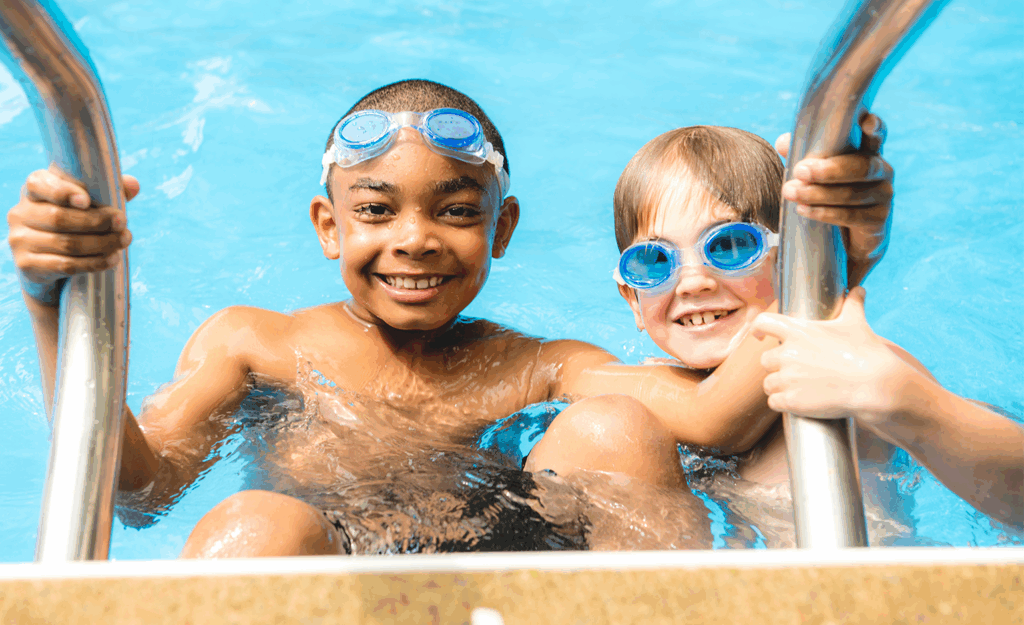Swimming is a favorite pastime for many Americans. It ranks as the country’s fourth most popular recreational activity and the top activity for kids and teens ages 7-17. With so many options—backyard pools, public swimming pools, lakes, rivers, and oceans—it’s no surprise that families often enjoy swimming as a summer activity.
While swimming is fun, it’s not without risks. Whether you find yourself in a chlorinated pool or natural water, knowing the different hazards each presents is important for staying safe this summer.
Understanding the different risks: Natural waters vs pools
Swimming pools and natural bodies of water offer very different experiences. Pools are controlled environments. You know the depth, the temperature stays steady, and swimming hazards are easier to see and plan for. Pools are typically supervised, and public swimming offers the safety of a lifeguard.
Natural waters are constantly changing and are affected by weather, season, and time of day. Other unpredictable elements are present in natural bodies of water, increasing dangers—currents, drop-offs, and low visibility can take you by surprise.
These differences matter, especially when it comes to drowning risk:
- Roughly 4,000 drowning deaths occur annually in the US
- For children ages 1-4, drowning is the leading cause of accidental death, with three times more deaths occurring in pools than in natural waters
- For ages 5-9, deaths are evenly split between pools and natural waters
- From age 10 through adulthood, the risk shifts—you’re five times more likely to drown in a lake, river, or ocean than in a pool
Pool safety: Key considerations
Pools may seem like the safer option—and in many ways, they are.
You can see the bottom, there are no waves or currents, and there is more control over the environment. Pools still have risks and hazards.
- Slippery pool decks increase fall risks
- Shallow diving can lead to serious head or neck injuries
- Suction fittings and drains can entrap hair, limbs, or clothing
Before jumping in, always:
- Check that the water is clear enough to see the bottom
- Know where the depth changes and swim in areas best suited for your skill level
- Only dive in areas that are at least 9 feet deep
- Keep an eye on children at all times—even in the shallow end
- Avoid pool drains
Most people expect drowning victims to splash and yell for help. But in reality, drowning is often silent, with the victim unable to call out. This is why constant, attentive supervision is essential, even in shallow water.
Studies show that only 56% of those who claim they can swim are actually able to perform basic water safety skills. For maximum safety, consider swimming in pools with lifeguard supervision.
Natural bodies of water: Safety by environment
Lake swimming safety
Lakes may look peaceful, but they can be deceptive. Unlike pools, lake water can be murky, with sudden drop-offs and hidden obstacles like branches or rocks.
Keep these lake swimming safety tips in mind:
- Enter the water slowly and test the bottom with each step
- Swim only in designated areas with clear boundaries
- Wear a properly fitted life jacket in deep, murky, or unfamiliar areas
- Check for harmful algal blooms, especially during hot weather
- Check local water reports before heading into the water
- Avoid swimming after storms, which can stir up debris and bacteria
River swimming dangers
Rivers present perhaps the most deceptive dangers due to their moving water. Even slow-moving water can hide currents that can pull you under in seconds.
Follow these tips for staying safe while swimming in rivers:
- Avoid swimming in high water, which can be indicated by flooded grass or submerged bushes
- Watch out for strainers (like tree branches), hydraulics near dams, and undercut rocks
- Always wear a life jacket—even strong swimmers can be overwhelmed by the current
- Swim with a buddy and avoid isolated areas
- If caught in a current, swim at an angle toward shore rather than trying to fight against the flow
Flash floods can occur suddenly—especially in the mountains or after rain—so always check the forecast.
Ocean and beach swimming safety
Ocean swimming introduces powerful forces not present in pools or lakes: waves, tides, and rip currents. These elements can overwhelm any swimmer if they’re not prepared.
Ocean swimming dangers to be aware of:
- Rip currents are powerful channels of water flowing away from shore that account for more than 80% of lifeguard rescues. If caught in one, swim parallel to shore until you escape the current, then angle back toward the beach.
- Learn beach warning flag systems—they signal water conditions at a glance
- Avoid swimming near piers, jetties, or rocks where currents can be stronger
- Watch for marine hazards like jellyfish or sharp shells
- Always swim near a lifeguard tower and never turn your back on the waves
Conditions at the beach can change quickly. Check the tide schedule and surf report before getting in the water.
Safe swimming practices
Some safe swimming rules apply everywhere, no matter where you swim—pool, lake, river, or ocean.
Honestly assess your swimming ability. The American Red Cross defines water competency as the ability to:
- Enter the water and completely submerge
- Resurface and float or tread water for at least one minute
- Turn 360° and locate an exit
- Swim for at least 25 yards
- Exit the water safely without using a ladder or steps
Additional water safety tips:
- Never swim alone—always use the buddy system
- Learn basic CPR and water rescue skills
- Avoid alcohol before and during swimming
- Use U.S. Coast Guard-approved life jackets for kids and weak swimmers
- Check the weather conditions before heading to any body of water
- Parents should maintain “touch supervision” for young children, keeping them within arm’s reach at all times
Special considerations for children and inexperienced swimmers
It’s important to pay close attention to children around all water environments. Water safety organizations recommend supervision, barriers, safety gear, and early swim instruction.
When introducing kids to natural waters, starting in calm, shallow water with good visibility is important. Use properly fitted life jackets and maintain “touch supervision” for your kids. Choose swim areas that match your child’s abilities. Remember that flotation toys, water wings, and pool noodles are not safety devices and should never replace proper devices or supervision.
Choosing the right swimsuit color
You may choose swimsuit color based on what you like or the latest fashion trends, but it plays an important role in water safety. Bright, high-contrast suits improve visibility in the water, helping lifeguards, parents, or bystanders spot someone in distress more quickly.
- Pools: Neon orange, yellow, and blue stand out. Avoid white or light blue, which can blend with the water and pool floor.
- Lakes: Choose neon orange, bright red, or yellow. Avoid green, brown, black, or navy suits that can disappear in darker lake water.
- Oceans: Neon pink, orange, or red show up best against ocean hues. White, blue, and green suits can blend into the ocean environments, making swimmers harder to spot.

Whether relaxing in a backyard pool or exploring a natural lake or beach, swimming safety starts with awareness. Pools may offer more control, and natural waters require heightened caution. By taking environment-specific precautions and practicing smart swimming habits, you can enjoy the water safely—wherever summer takes you.


